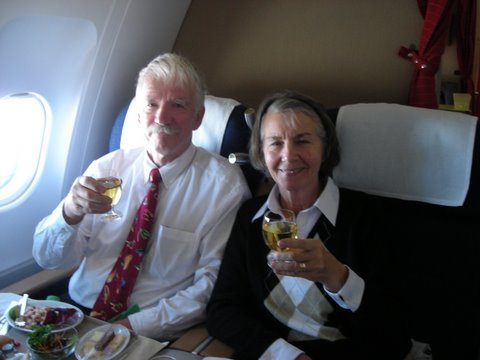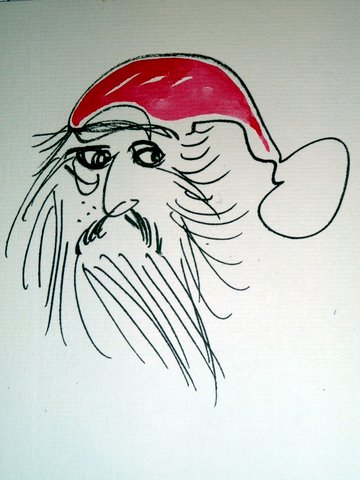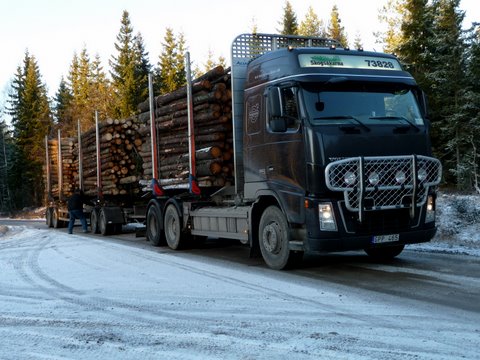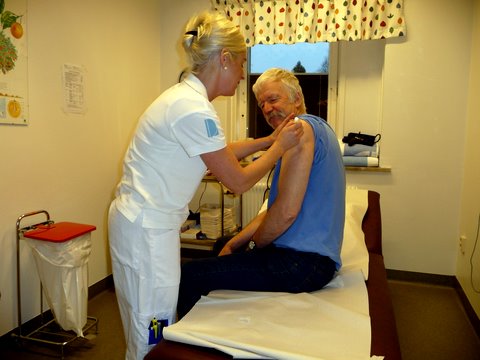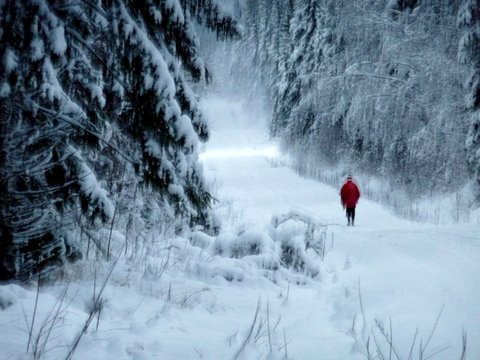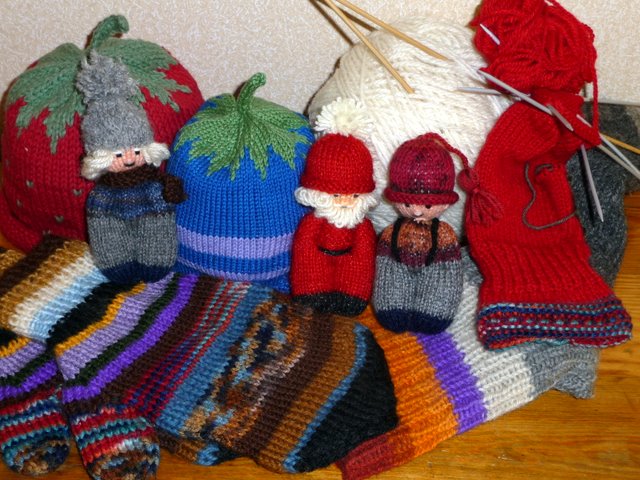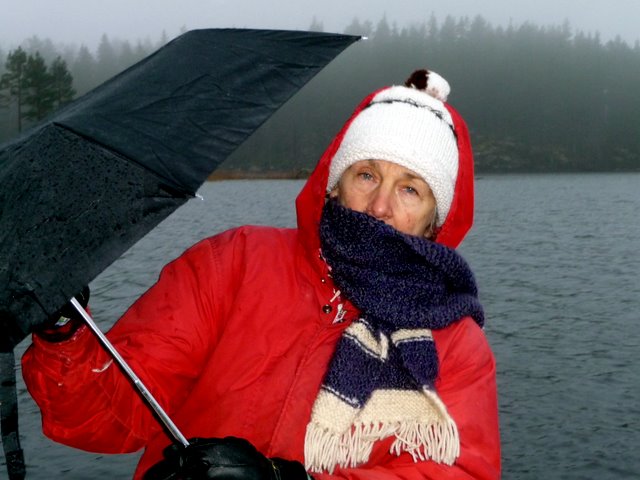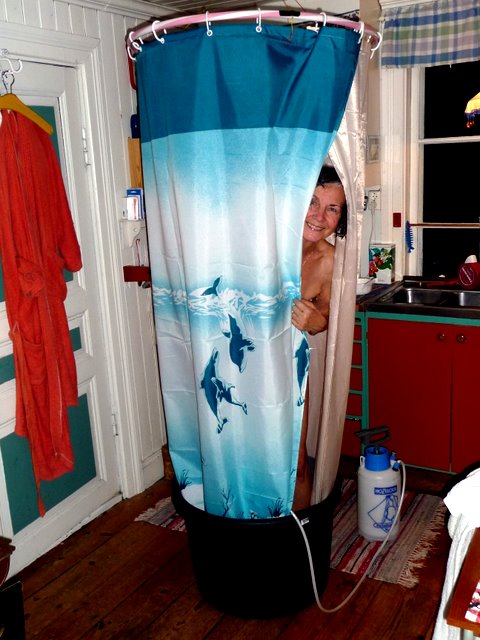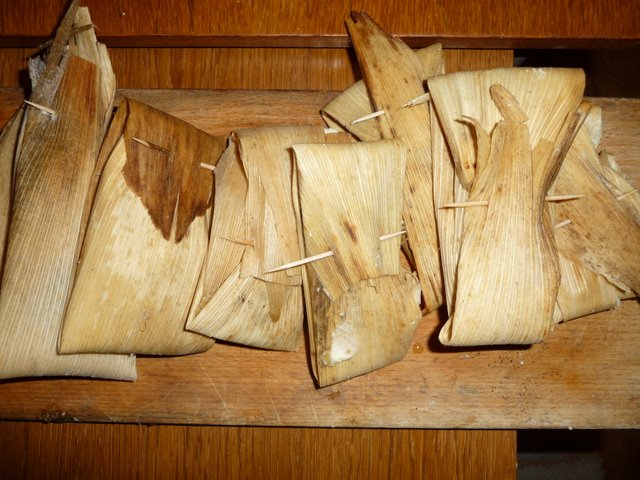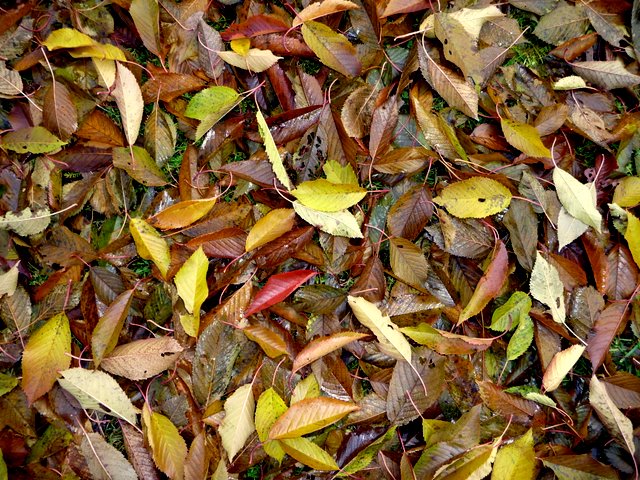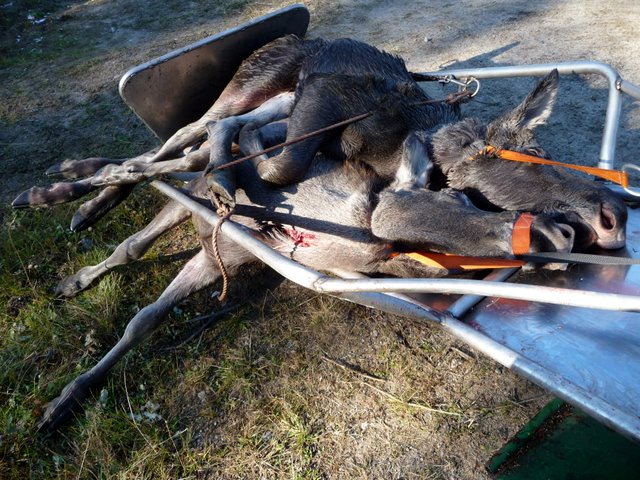| MONTHLY JOURNAL 2010 |
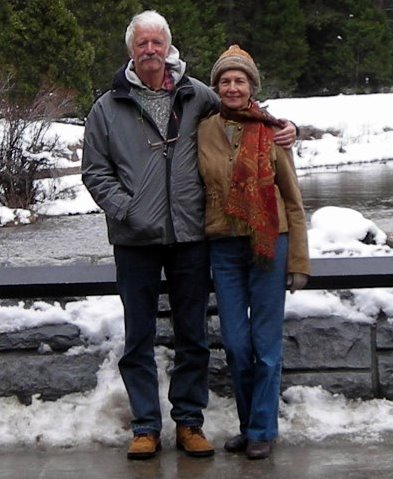 |
|||||||||||||||||||||||||||||||||||||||||||||||||||||||||
|
Winter hits us surprisingly early, before we are practically or mentally prepared. Suddenly, one day gray clouds sweep in from the southwest, chased by roaring storm winds, the sun is darkened and a heavy snowfall blots out everything except the nearby surroundings. In the morning we wade through deep snow-drifts, clear snow from stairs and paths, dig out the car and call for tractor assistance. “North Atlantic Oscillation”, the meteorologists happily announce. A periodically returning phenomena resulting in extreme cold and lots of snow. Interesting to know, of course, but it doesn't make snowdrifts less cumbersome.
The interest among my
fly-fishing customers decreases as the snow increases. The last flies ready
to go by post is a bouquet of Boobies of varied colors. This particular fly
was introduced as a nymph-imitation at British reservoirs about 35 years
ago, and proved to be so effective that it was banned in certain waters.
Nowadays it is mostly used as an attractor-fly or a fry representation. Many
use it combined with a sinking fly-line, thus achieving a very special
effect. The light styro-foam bulbs strive to rise, towing the leader, and
the fly ends up temptingly waving halfway to the surface. Works great, says
my enthusiastic customer.
October – a time of rain and mist. The month when nature goes into repose, chilly winds sweep through waterlogged forests and the Nordic gloom gets a hold on us. A short-lived period of high pressure with agreeable temperatures, blue skies and a blessed tranquility causes our spirits to soar. During a shopping trip to Falun we take a break by Lake Svärdsjön at Trollnäs. Water, smooth as a freshly ironed sheet, mirrors trees and islands. In the warm sun, vapor rises from the earth and for a short while summer is back.
Our meadow, brown and wild,
undergoes a quick transformation, when one day Håkan arrives with his
brush-cutter and clears away decaying grass and straggly bushes. It is at
the last minute, for just when I have finished raking and putting it all
away, the first snowfall of the season pulls a white blanket over the naked
ground. Vole and field-mice, living well under the grass cover, disappear
like magic. Other animals appreciate the clean-up. The very same evening we
are visited by a few deer, and later that night, by a moose stamping his
hoof marks deeply into the soft earth.
The bear hunting season ended
a good while back. Southwest of Ågsjön, near Österbyn, two bear, a male and
a female, were killed. One of these, probably the one we met at Malm-myren a
few days prior the hunt. This month means moose hunt!
Bibi has had a trying summer after her accident, but at times has less pain and takes off her sling to resume her regular household chores, or manages some knitting or jewelry making. Early mornings there is frost on the grass, and in the daytime dense fog covers the landscape. Fishing from a belly-boat on one of the lakes becomes somewhat different when contours disappear. and no landmarks catch your eye. One is overcome by a feeling of hovering weightlessly between heaven and earth in an endless nothing. Like a ghost a small island appears in the mist, only to fade away in the fog as you move on. A weird, almost unearthly experience.
On rainy days I try to speed
up the fly tying activity. My Balsa-Europea No.12 from last spring has
caught well to judge by recent feedback, but presently I concentrate on my
small sized “Rednecks”. Reynold Grönlund of Wilhelmina, the founder of
Grönlunds Sport, had many years fishing experience in his region. He noticed
that, as a rule, flies with a touch of purple caught more fish than did
other patterns. Based on this observations his son Sven designed the popular
wet-fly, “Deep Purple”. I will pick up Grönlund's idea and add dark bluish
purple to the fly body. This will be my next project.
At the end of the month we gather for the yearly pike-fishing at Borgärdes-strömmen, our club water. A beautiful trout -and greyling stream, in the month of September enhanced by bright autumn colors. During 3-4 hours we fish the main stream and its forks, preferably deeper parts where the water slows down. To sum it up, 11 kilos of pike are landed. The biggest one is taken by Jonas, who on a streamer caught a fish weighing a good three kilos, probably with a number of greyling on its conscience. The day ends when our cooks serve a hearty pea-soup made over open fire and seasoned with Johnny's Homemade Mustard. A rusty brown leaf precariously lands in my soup – snow is not far off.
Autumn creeps up upon us. The waters get a deeper shade of blue, and fading reeds erase the line between lake and marshland. Pike which now have found a comfortable temperature in shallow water, are easily lured by slow moving poppers. The takes are violent and mostly unexpected. During a short break from casting my boat drifts in the light wind toward the shore. A Canadian goose lies immovable in the moss and shows no sign of fear as I come close. ”Branta canadensis”, a beautiful bird that was introduced to Sweden as early as the 1930:s. Followed by thousands more, and in compliance with its instinct, it will soon take off for southern climes.
A planned windpower park in
the Svartnäs area spreads unrest. A local group of people stubbornly oppose
this plan, which may eventually destroy this wilderness environment enjoyed
by hundreds of Swedish and foreign visitors, as well as permanent or part
time residents. Along with other wind power projects, partly completed, the
result will be 180 (!!) windpower mills, 180 meters high. Add to that miles
and miles of new roads and power lines cutting right through the heart of
the forest. A gigantic destruction of nature. The wilderness and the
beautiful recreation areas will, if the plans go through, be turned into one
great, noisy industrial park where neither animals nor people may dwell. One
day we run into a huge transport of a component to a wind power mill, we are
awed at its size and feel thankful that Vintjärn is only marginally touched
by this.
Each summer has its fly, and this year it's Chernobyl Ant. At what time, after the Tjernobyl catastrophy, in 1986, the first mutant appeared, I am not aware. But 5-6 years ago I found the first specimens in a sportfishing store in Texas and bought a couple mostly out of curiosity. The Chernobyl Ant does not really resemble any living thing on this Earth, but it catches fish – oftentimes large fish. Lately it has mutated further, received both hackle and antennaes, and in some cases certain resemblance to beetles, crickets, etc. I tie them on streamer hooks, sizes 8-10 and use silicon legs rather than rubber, which has a tendency to stick together and eventually dry up.
The vegetation is amazingly lush this year, fire weed reach above our heads, and deep in the forest, where we have never seen them before, orange lilies shoot up from the ground and explode like fireworks of red and orange shades. Some visitors enliven our existence at the beginning of the month. An enthusiastic group from Norway appear one day in our yard. Most of them come from Steinkjer, and all trace their ancestry to our house. They are traveling around in search of their roots in the Swedish soil. A pleasant meeting which concludes with one of the feminine members singing a Norwegian prayer to the sun. Her voice, as clear as bell, carries across the neighborhood.
Two weeks later a group of
Germans arrive and lodge at the manor house. They are interested in mines,
quarries, foundries, etc. We are invited to a delicious smörgåsbord, where
every dish represents a geological or mining phenomenon. Later we take them
to “Solgruvstugan”, drive to the foundry at Åg, stroll around the “fäbod”,
then return to home to look at this year's photo exhibition. All are
impressed by the dedicated work of Maj-Britt and Margit, who have documented
the life in and around Vintjärn. To conclude our fellowship we invite
everybody for a cup of coffee on our lawn. With thundering voices, as if
rising from the depth of the earth, our guests see fit to give thanks by
singing a German mine workers' song.
A few chilly days with rain and heavy winds at the end of the month stir up Ågsjön's water. Pike are beginning to seek their positions in the shallows or near clumps of weed in the bays. Although pike have few demands on water quality, they are sensitive to high temperatures and are more comfortable in cold water. Relatively small streamers with mint green wings give good results. But, the importance of a particular fly-pattern could be discussed. C.U. Ekström (1831) writes: “Very greedy, she, in her wet element, attacks not only anything alive she believes she can overpower, but even dead and decaying bodies will be her pray”.
We travel to Karlstad, our former home town, in order to celebrate the Swedish national holiday and get together with friends. We take a nostalgic stroll through beautiful Mariebergsskogen, and visit Sandgrundsudden on river Klarälven, where festivities are taking place. There is a great turnout, it is warm and sunny with postcard pretty skies. Sitting on the grass we listen to the Sinfonietta conducted by charismatic Marie Rosenmir. When the official program is over, there is dancing on the landing pier to accordion music by Karlstads-bälgarna. Later on, we spend the evening with our old friends Marianne and Per-Olof, where we enjoy jazz and fine wine.
Midsummer is not quite the
same this year. Two weeks before the summer solstice Bibi takes a violent
fall while dancing at a party in the village. She breaks her right arm and
wrist, and I drive her to the emergency room at the hospital in Falun. After
her wrist operation just before midsummer we don't feel up to joining the
traditional celebrations in Svärdsjö. We confine ourselves to just imagining
the folk costumes, the fiddlers and the dance around the maypole. After a
peaceful evening the sun slowly goes down behind the treetops, the bird song
ceases and the short Nordic midsummer night begins. On a meadow somewhere a
young girl picks nine varieties different flowers to place under her pillow
hoping to see her husband-to-be in a dream.
Isala Lada is a tiny, weather-beaten old barn near Svärdsjö. It is not much to see these days, but one dramatic day in the winter of 1520, Gustav Wasa was hiding there when fleeing from the Danish occupational forces. To fool the troops, a resourceful farmer's wife, along with harsh threats, sent Gustaf to the barn to thrash wheat. Just imagine, the most sought after man, who only three years later became the king of Sweden, was just a 24-year old youth at the time! Visitors, wanting to show that they have been there, carved their initials into the wood. Some of those, dating back to the 18th Century, show that graffiti was not an unknown art form even then - but without spray cans.
From Chicago via Baltimore
Bibi takes a flight to Boston, a friendly town which is her last stopover
before flying home. I have been given the honorary commission to give the
traditional Walpurgis Night speech, before the fire is lit and the fireworks
go off. I speak about the origin of the celebration and about the 17th
century poet, Lars Wivallius, who from behind prison bars in Finland wrote a
poem of his hopes for the approaching summer. I round it off by citing one
of the verses, ending with the lines:
The day after Bibi's arrival
from the United States I travel to Sundsvall to attend Scandinavia's largest
fair on outdoor life. My travel companion is English fly-tier Chris Carter,
who makes the neatest sedge imitations I have seen. Three days, morning till
evening, are spent in the huge exhibition hall containing everything related
to fishing and outdoor life. I am expected to show how I make flies in odd
materials like balsa-wood and cork, though to tell the truth, few flies are
made. On the other hand I get to meet a lot of nice people, listen to
innumerable fishing yarns and even find time to study my fellow tiers
techniques. Memorable are Mikael Gröndal's intricate pike flies and Håkan
Karsnäser's exquisite salmon flies.
May is the long awaited month when the snowdrifts of winter change into drifts of white windflowers. This is the beginning of summer. Beetles, bumblebees and butterflies have come alive, black ants swarm along the house foundation, and chilled lizards bask in the sun on the log walls. For the first time we can enjoy a cup of coffee outside the cabin, without having to wrap up in warm clothes. And yes, I catch my first pike in lake Ågsjön. Curiously enough, its not a clear-water pike, since the pattern on its body has a rusty-yellow color. It probably came from one of the small wood tarns, reaching the lake by negotiating flooded bogs along its route. My fly is a present from Peter Andersson who has tied a classic Brook´s Blonde, embellished with a few sparkling tinsel-strips.
Right after Easter we are hit by a heavy snowstorm. In just a few hours spring turns into winter again. Fortunately it is followed by a long period of mild weather, which makes the new snow disappear almost as fast as it came. The contours of the landscape appear once again, and the roads become free from snowdrifts and ice. It's time to change the tires of the car, a pleasant yearly event. The cranes have arrived, and around sunset I can hear them trumpeting down in the glen. Small birds fill the day with their twittering and melodious sequences, and on the 11th day of the month I register the first genuine spring day with sun, blue skies and mild winds. From the States Bibi tells me, by way of mail, of a fantastic flight from Texas across the Sierra Nevada to California.
I bring out a ladder to
perform yet another pleasant task, that of taking down the bird houses,
cleaning out the old nest constructions to give room for new ones. Which
bird built the prettiest nest 2009? Well, first prize goes to the
flycatcher, which in spite of rough and stiff material has succeeded in
making a nest both sturdy and comfortable. The worst nest of all is made by
the nuthatch, which simply has dumped a heap of half-rotten bark chips at
the bottom of the box. But to be fair, the nuthatch really does not care
much for bird houses, but usually prefers a crack or a pocket in the
tree-trunk.
Another spring chore is to launch our small boat into lake Ågsjön. The boat has wintered well thanks to its glass fiber hull. It is a warm day, and not a trace of ice left. Small islands are decoratively grouped in places where 10.000 years ago an ice-river by chance deposited its sediment of sand and stones. Farthest to the west lies Svältöa (Starvation island), named from an old myth about a wedding party which stranded on the little islet, and had to starve until rescued. The Canada geese have arrived and are busily staking out their claims on the bogs, where their modest nests are to be made. As for myself, I look forward to my first pike fishing of the year.
From her journey to New Mexico Bibi sends a picture of a barren desert landscape. A stark contrast to my environment of snow and ice. On the road she passes places like Sonora, Pecos, Cimarron and Ponderosa, all well-known names from so many Westerns. A few years ago we visited Pecos, a small village known for the self-appointed judge Roy Bean, “The law west of the Pecos”. He died after a binge drinking party, in year 1903, but his saloon is completely intact with scratch-marks from spurs and all. On the wall a wooden sign with the house rules. One of his most notable cases was when he gave a corpse a 40 dollar fine for carrying a weapon. Apart from the pistol, 40 dollars was the same amount found on the dead man. The money, of course, ended up in his own pocket.
The fox, which shares quarters
with the badger under our barn, visits me one day. Lightly stepping on the
crust of the snow he crosses over the field and comes up to the house. I can
see that he has wintered well. His fur is lovely and thick, his glance
spirited and alert. Mating season is here, and on dark nights I can hear his
short and cut off bark, sometimes close by and sometimes at a distance.
Through knee-deep snow I make my way to the barn to see if the badger has
awakened from his winter sleep. From his den fresh tracks lead off to the
trees. He must be good and hungry, his body weight perhaps only half of what
it was last fall. A badger can easily devour a couple of hundred worms a
day, but in this snowy landscape he won´t be able to find a single one.
Soon birdsong will sound from all trees and bushes, but still a nearly compact silence rules over forest and grounds. On some nights I see an airplane draw a jet-stream across the sky. I imagine the passengers with drink in hand comfortably leaning back in their seats. Warm, snug and safe in their closed environment, 10.000 meters above the surface of the earth, on their way to Iceland or USA. The sound of the engines is barely audible, but causes the silence to deepen around me and enhances the feeling of desolation and wilderness.
February is very cold with plenty of snow. Strong winds create mighty drifts which make it difficult to travel on the roads. Shoveling snow becomes a daily chore and our property gradually turns into a system of narrow passages with high walls on either side. When, during the long and dark evenings by the fire we read or listen to music, we hear the storm violently attack the timber walls of our house. All bundled up, we venture out only to fetch wood and water.
On occasion, a bleak sun
manages to penetrate the cloud-cover and we go to fetch our skis. Using
snowmobiles, enthusiastic and competitive skiers try to keep some practice
ski paths open. The paths are well groomed, running in harmonic loops
through gently undulating terrain. It is a liberating feeling to be able to
stretch out after beeing cooped up for hours on end. On both sides of the
path, silent, snow-clad forests, disturbed only by the rythmic sound of skis
rustling against a sleek surface. I discover that the competitive instinct
is still there, although nowadays I only compete with myself.
In the middle of the month Bibi travels to the US to visit with children and grandchildren. In her luggage she carries a collection of newly knitted “gnomes” for St. Patricks Day, which she will spend in Boston, a city with a large Irish population. I drive her to the railway station in Falun and we enjoy a cup of coffee while waiting for the train to leave for Arlanda. Dusk is upon me when a few hours later I unlock the door to an an empty house. The day turns into night and somewhere in the increasing darkness a lonely fox calls for his partner.
New Year's Eve is spent with
our friends Monica and Åke in their mansion-like home at Dammhöjden (the
pond). As midnight hour approaches we stand on the porch beneath a twinkling
starry sky and wait for the strike of 12. In vain we listen for the bells of
the church in Svärdsjö, but the soft ringing is lost in the snow blanketed
forests. Not a sound can be heard around us. We raise our champagne glasses
and wish each other a happy 2010 before starting for home in the winter
night. It has turned noticeably colder and the chill bites our cheeks, the
frozen snow crunches under our shoes and a new year has already begun to
grow old.
Heavy snowfalls, increasingly
cold weather and a much criticized wolf hunt start off the new year.
Shoveling snow becomes a daily chore in order to keep the courtyard clear
and time and again we are snowed in. Only with the help of a friend and his
tractor are we able to get out with the car. Much time is spent indoors
where we stay occupied with other things. The harsh weather encourages my
fly-tying business, while Bibi makes feather earrings and devotes many hours
to knitting or to sorting old pictures. The wolf hunt which, according to
our minister for environmental issues, is aimed to strengthen the stock of
wild wolves, turns out to be short-lived. No wonder, with 12 000 (!!)
hunters roaming the forests. 28 wolves were killed, of which a number were
wounded and had to be found. How a not so vigorous wolf population of 230
animals would prosper by reducing it further, is beyond most of us.
As the month nears its end, snowfall follows snowfall and the temperature stubbornly stays between -10 to -25 C. Behind us is a stretch of short and very quiet days, one day much like the other. The whole landscape is enveloped in a heavy curtain of snow. It hangs in thick folds from tree branches, forms soft waves on uneven surfaces and extends smooth and unbroken across the fields. Apart from the native birds begging for food outside our kitchen window, we don't see much animal life. The four-legged ones are active mainly during the dark hours. In the early mornings we read the signs in the newfallen snow. Tracks from fox, hare and deer are most common, but one night a moose has laboriously made its way through the snow drifts some 30 yards from our house.
We woke up one morning
realizing that December has arrived, with Christmas rapidly approaching the
thought of sending Christmas cards presents itself. This year we can’t
escape this pleasant burden by being far away in Mexico. The cost of masses
of commercial cards to customers, friends and acquaintances causes some
reluctance. One solution is to make a personal Santa motif, leave it to our
printer in Svärdsjö and, for a reasonable sum obtain a bunch of identical
cards. A few short snowfalls at the beginning of the month cause the lumber
company to hurry and haul the timber from the forest before the roads are
closed. All day we hear the heavily loaded trucks passing just north of our
house.
For fear of contracting the
Mexican swine flu, most Swedes agree to the recommended immunization. The
delayed flu vaccine finally arrives at the primary care center in Svärdsjö.
The atmosphere is somewhat jolly, as often, when people face a common
ordeal. We receive a queue number, wait for a few minutes for the sting in
the arm, and it’s all over. Our charming nurse readily agrees to pose before
the camera as we ask to immortalize this event.
Heavy clouds are mounting, and by afternoon the snow is here. At first, a few single flakes, but soon it is a full-scale snowstorm. When we raise the shades in the morning, the landscape has been transformed; hills and forests are covered by thick snow so intensely white that it almost blinds us. By the end of the month our faithful friend, Sven-Erik with his tractor have come to clear the snow at least three times so we could get out. We spend Christmas peacefully by a flaming fire, read and listen to music. The darkness is like a black wall outside frosty windows. Midwinter!
All of a sudden, it is
November. Christmas is at hand at Bibi hurries to knit her various articles
for friends and relatives and for an occasional sale.
After spending several winters in Mexico, our menu sometimes gets a hot touch during the cold season. Here is a dish, seldom seen among all the exotic recipes published in our weekly magazines. “Tamales”, always a success with our friends, are made from corn meal dough with chili, chicken or pork, flavored with hot mole or green sauce, wrapped in cornhusks and steamed for an hour. Good with tequila and/or beer!
The trees become bare in no
time at all. A gust of wind and the leaves fall to the ground like a shower
of gold coins as the sun periodically peeks through the clouds. The moose
hunt closes early in the month. The last moose, two young calves, are shot
just a few hundred meters from our house. We venture out in the woods to
chat with the hunters. On the slopes above the logging road they have run
into a bear and a couple of roaming wolves, and south of the village on the
shore of Långvintjärn a hunter ran into a female bear with her three cubs in
tow. In spite of him waving and hollering, the bear kept coming
uncomfortably close, and he had to give a warning shot for self-protection.
“Böl’s church”, in the woods
between Vintjärn and Böle, is a giant erratic block placed there by the
inland ice about 10.000 years ago. This giant boulder is a full 12 meters
high and seen from a certain angle, it leans like the famous tower of Pisa.
It is narrow at the bottom and stands “like on a stem” as the district
researcher Karl-Erik Forsslund once expressed it. You can easily reach it
from a logging road as long as it is clear of snow. Now and then I pass this
huge boulder when fishing Vinnar-ån, a small trout stream that meanders
through alternatingly boggy, forest- and block terrain.
The first snow hits us on the 12th of the month and the landscape receives a thin layer of new snow like the frosting on a cake. Suddenly all sounds are muffled and we are enveloped in a cocoon of silence. Early mornings we can track moose as well as fox and hare. The cold becomes more and more obvious. Our laundry, hung with numb fingers, quickly converts into unmanageable stiff “sails”. Time to prepare for winter! Make sure the chimney is swept, stock up on firewood, darn woolen socks, change tires on the car and fill the bookcase for long winter evenings by the fire.
A new month and the bear is
preparing for its winter sleep. I travel to Norway and my friend Ola for a
week of fishing, only to find my river unfishable. The water is much too
high, grey and filled with millions of autumn leaves brought down by the
storm. We do other things, like spending one whole day high on the beautiful
mountain heath. In a sheltered spot we enjoy a cup of coffee and reminisce
about the summer in 1983, when we climbed the highest peak of the Sölen
massif. I was in bad shape after a major operation, and Ola suffered from
back pain. It took us all day – but we made it!!
Bibi spends all of September
in the US, mainly to attend the wedding of Roland and Kari at the Emanuel
Swedenborg church in San Francisco. Besides visiting three daughters in
Boston and Baltimore, she also has time for some fishing with friends. At
the Rappahannock estuary on the Atlantic, the party catch a variety of fish,
among them a Blowfish. A curious looking thing which, when frightened,
quickly blows itself up. On the last day of the month Bibi takes off from
Philadelphia with US Airways, and on the next day I fetch her in Falun, as
she arrives by train from Arlanda airport.
September is usually my best month for pike-fishing. This year is different. After heavy rains, overflowing lakes and ponds are difficult to fish. Strong winds don’t make it any easier. I fish various sizes and colors of Brook’s Blondes, but with poor returns. The pike that do bite are consistently small. The hunting season for moose is coming up, and I will have to plan my fishing excursions with this in mind. Many hunters complain about the subsiding moose stock, often blamed on the increase of bear and wolf.
The slowworm lies like a decorative sling on the path. After a cold night it
is quite stiff and makes no resistance as I carefully lift it. In just a few
weeks summer has turned into autumn. We can read the signs: The silence, the
early morning veils of mist in the valleys and the changing colors of the
trees. On days when the sky is high and clear, views are wide and the hills
show various shades of blue. Constant rains have saturated the earth and
among the mosses between the tree trunks one can spot colonies of
chanterelles glowing like gold.
I have always been suspicious
of wild mushrooms. But the delicious chanterelle gives me no problem, since
it is not easily mistaken for poisonous species. This year we have found
more than usually and in new and unexpected places. Mushrooms don’t always
follow any rules and this in itself adds to the excitement. Finding a new
stand of this “gold of the forest” could readily be compared to the
discovery of a beautiful rise of a trout within easy casting range. The
chanterelle is best fresh and fried in butter. Its nutritional value may be
modest, but it sure is good!
At the end of the month I make one last trip to one of my small trout streams. In my breast pocket, a tin box with about ten flies, among them my favorite, the Wooly Worm. The terrain is cumbersome and branches and tufts grab after sloppy back-casts. It turns out to be a good day, though. The trout are not big, but attack like lightning from their lies under overhang and behind rocks. Toward evening the stream darkens below heavy skies, and when the last fish of the day flap about in the grass, the rain is pouring down. Wet, and somewhat stiff, I make my way up to the road. Of the ten flies I carried, hardly half are left - the others decorate trees and bushes along the banks.
This month goes down in history as one of the wettest in many years. A veritable deluge has come down upon us. Lakes, ponds and creeks overflow their banks. The big event of the month is Bibi's birthday, which we celebrate in the company of friends and relatives beneath the old pine-shake roof. Our daughter Virginia with husband Tim, visiting from the USA, do all the cooking, baking and serving. My humble task is to keep the fire going, heat water and wash all the dishes. A pleasant evening when Bibi, somewhat reluctantly, has to confess to being one year older.
On Midsummer Day year 1687, a
sudden collapse took place in the Falu Coppermine. A complicated system of
supporting pillars and large galleries caved in, creating a 95 meter deep
crater with a 1.5 km circumference, commonly called "Stora Stöten" (i.e. The
Big Blow). Miraculously, there were no casualties, since Midsummer Day was
one of only four days of the year when workers were off duty. Virginia and
Tim take a guided tour into the unharmed part of the mine. A good hour later
they return from the dark well informed about the incredibly primitive
mining industry of more than five hundred years ago.
At the end of the month we take our American visitors to Arlanda for their flight to Boston. We enjoy a cultural detour on the way home. First stop is Skokloster castle, a stately reminder of times gone by. Then north to lower Dalälven River and Gysinge old iron works, dating back to the 17th Century. Other attractions in the region include good fishing for grayling - and dense swarms of mosquitoes. Back home again we search the woods for raspberries among thickets and bear tracks. Berries are abundant, ripe and sweet. Harvest time is all over, the cuckoo no longer calls, and the wind carries a hint of early autumn.
A long period of warm weather around May-June makes nature come alive. In just one week, our house stands in lush greenery, warm winds rustle the birch foliage, rabbits and deer appear from nowhere. In cover of darkness, a moose ventures out from the forest one night. Birds have taken possession of our birdhouses. An aggressive flycatcher comes out to defend his territory from the nuthatch in the next tree. A female bear with three young roams nearby. At dusk, I can hear her chastising the offspring. One of the cubs shows up in the yard one afternoon, black as a raven, woolly and cuddly. Against a background of dark pines, our house is barely visible in the middle of the picture.
For once, we spend the midsummer holiday on the island of Väddö with Bibi’s sister and company. Very pleasant, but I miss the special feeling of a Dalarna midsummer with fiddlers and folk costumes. Bibi then flies off to France to attend a family reunion. She sends me a picture of herself “shrimping” in the waves in Normandie. As for myself, I spend three magic summer nights in my belly-boat on lakes Nysjön and Ågsjön. The Ephemera vulgata is hatching and I lose the largest trout I have hooked for many years. Following a couple of heavy rushes, the line slackens and a mighty tail fin teasingly waves goodbye.
The loss of the large trout, which rose to a “Tjernobyl Ant”, still irks me a little. Nevertheless, I am consoled by the fact that one cannot lose something one has not owned in the first place. Otherwise, the entire month has been about fly tying, disciplining myself to stay indoors. Rainy days were a blessing. The popper is much appreciated, pleasant both to use and to make. Many years ago, I would sometimes on ethical grounds, receive critical remarks about fishing the popper. The critics claimed that a fly should contain only traditional materials, no balsa wood, cork or synthetics.
Just in time for Walpurgis Night, the last snowdrift melted away and early spring flowers began to make their way through the decomposing leaves. The day before, the owl moved into his new house in the big pine. This made us very happy. We hope he will be comfortable, but since field mice are scarce this year, a growing owl family may find it hard to make the food go around. We celebrated the arrival of spring by joining the villagers in lighting the usual bonfire, and while mighty flames illuminated the sky, we sang our traditional, “Winter is over….”. Monica, all bundled up in the cold night, gave the traditional speech to welcome yet another spring.
With the snow all gone, the best time to stock up wood for the winter has arrived. In other words, we start taking down suitable trees, then saw the wood, split and stack it. Slow drying, wood needs a sunny and hot summer in order to burn well when winter sets in. After a bout at the chopping block, it is sometimes hard to switch to fly-tying. Hands get shaky from the hard grip around the axe handle, and the tying thread tends to become caught on rough fingertips. Better to start the day with fly-tying and finish with a dose of wood splitting.
Joe Brooks, American fly fisher and writer, was the adventurer not content with the usual travel destinations. During a time when we still thought of a fishing trip to Norway as a bit exclusive, Joe visited exotic places and caught exotic fish that we had not even heard of. When he died in 1970, he left to posterity, a series of flies, commonly called “Brooks’ Blondes”. One fly, “Argentine Blonde” tied on hook 2/0, gave me several pike last autumn and the same pattern opened this season. The first pike sank without hesitation his teeth into the slim blue-and-white streamer. Bibi mastered the oars and besides had time to make a picture.
We land at Arlanda on a misty morning after an overnight flight from Chicago. At the last minute, we catch an early train to Falun the closest town to Vintjärn. Sven-Erik, my old classmate has cleared the road to our house, which has stood deserted for months. There is more snow than we have seen for many years; the snowdrifts are nearly as tall as man. We wade waist-deep to make our way to outhouse and woodshed. Temperature is just blow zero C, and as soon as we get the fires going the house feels warm and cozy. We relax with a cup of coffee by the crackling fire after a “day” that lasted for more than two days and nights.
Winter is nearly over. However, before the light returns, we experience a few cold nights when the sky sparkles with millions of stars and galaxies. We feel small in an infinite universe. Only the constant song of the Tengmalm’s owl disturbs the total silence at night. At the end of the month, the weather gets warmer. The snow quickly melts creating rivulets on the slopes. Our well water takes on the color of light beer. The fox and the badger, sharing living quarters under the barn, make extensive trips in the surroundings. The badger, just awakened from his winter sleep, plods through the snow on short legs searching for something to fill his empty stomach.
We leave the Pacific Coast and drive on slippery winter roads to the overwhelming wilderness of Yosemite Valley. We spend the night in a heated tent, our food in a metal locker outside. The black bears here do not hibernate! Now and then, huge avalanches rush down the nearly perpendicular mountainsides. After the typical green hills of California, we find ourselves in a landscape of snow and ice. In 1864 the area was protected against development, when President Lincoln signed the Yosemite Grant. The native Ahwahneechee Indians disappeared after hand and gave way to naturalists, artists and later, to tourists. We are greatly impressed by the Sequoia trees. Tough giants that were just green shoots during the reign of Cleopatra in Egypt, i.e. a century before Christ.
This view, usually photographed in summer, with the Merced River with Half Dome in the background, often turn up in fishing articles and books. For those who want to fish here, a barb-less hook is the rule. The rainbow is natural to Yosemite, and is not to be killed. Brown trout, on the other hand, is a newcomer and may be caught and eaten, if you are happy with five per day. What else? Yes, on Sunday morning we went to the village church, and since we were visitors from far away, the small congregation applauded us.
We don’t see much animal life at this time of the year, but we succeed in getting a picture of a group of unafraid mule deer that have gathered on snow-less ground. Otherwise there are, besides many different birds, fox, squirrel, raccoon, coyote, rattlesnake and black bear. Mountain lion (puma) live on the slopes, a cat of about 70 kilograms of pure muscle. A brochure informs you how to behave if you encounter an aggressive puma. “Stand still – look the cat in the eye – wave your arms and yell – throw objects at the animal. If, in spite of this, the puma, attacks you, STRIKE BACK!!!”
Many, both young and old, put on their beautiful folk costumes during Catholic holidays, and with passion and joy, perform whirling Mexican dances to lively Mariachi music. The celebration of their saints becomes a mixture of religion and the paganism. We enjoy going to mass and are used to kneeling and making the sign of the cross in spite of our protestant background. One day, as we pass the church, the priest is standing by a side door, blessing the people who bring symbolic gifts to the Virgin of El Pueblíto. Incense is rising like a light summer cloud in the blue sky. The priest sprinkles holy water on the people that have gathered, but soon finds that he can’t reach everyone. He solves this by filling a spray-bottle. Bibi and I also receive a puff of the blessed mist. Psst! psst!
The road to Concá leads through the land of the mountain Indians, and is not for he who has a tendency for vertigo. Houses seem to hang like swallows nests on the steep mountainsides. The air is thin and chilly. A steep downward road takes us to Jálpan, and soon after, we arrive at Concá. The village is small and insignificant, but has fascinating surroundings. Warm springs well from the ground, the mountain slopes are draped in almost impenetrable jungles, and a beautiful river runs through the valley. We make our way in a terrain where branches, vines and tree roots reach after us like greedy fingers. On the shore, we run into an angler, resting comfortably against a huge tree trunk. We ask what he hopes to catch, and the answer is “trucha” (öring). We have stayed at Concá for a few days and travel back to El Pueblíto tomorrow. We agree that after nearly five months, it is time to begin the long journey home.
On a Thursday evening, we fly from Mexico City and arrive late at night in San Francisco. Not the shortest way to Sweden, for sure, but we are in no hurry. During a couple of hectic days, we enjoy the typical tourist attractions in San Francisco. We pose by the Golden Gate, take a random look at San Quentin and the island of Alcatraz, go by cable car on steep hills to Chinatown, enjoy a bowl of clam chowder at Fisherman’s Wharf and look at the sea lions seeking night quarters on Pier 39. One day we travel along the coast to the lighthouse at Point Reyes and later, wander for hours in the famous Redwood Forest.
Our New Year starts with the traditional “corrida de toros” at Santa Maria, the bullfight arena in Queretaro, Mexico. Ranchers from the district, who have brought their genetically selected fighting bulls from green pastures to a walled in “toril” under the arena’s bleachers, tensely wait to see how their bulls will perform. From our barrera seats, pleasantly shadowed at four in the afternoon, we see the matador in a glimmering “traje de luces” (dress of lights) throw his “montera” across his shoulder with a gesture, which, depending on how the headwear falls, means either luck or misfortune. Suddenly the arena is empty and, at a trumpet call, the door of the toril is opened and the eyes of the spectators focus on a mighty black bull rushing out to the circle of well tended sand. One of the matador’s cuadrilleros catches the bull’s attention and handles his red-orange capote in a slow and sweeping movement when the bull, grunting with pent up energy makes a wild attack. I have always had an interest in the corrida since my summers in San Sebastian and Pamplona, where at a reasonable price I could watch great matadors like Antonio Ordoñez, Paco Camino and El Viti perform on the arena. I appreciate the music, colors, rituals, traditions, seriousness, pride and the incredible courage. Many regard bullfighting as morally unacceptable, and organizations like “Antitaurina” works hard to put a ban on it. My approach to the corrida is mainly emotional. I may feel disgust after a bad corrida, but I always experience a pleasant chill along my spine when the orchestra intonates “el Gato Montes”, a paso doble often used when a matador in the latter part of the corrida performs a magnificent “faena” bordering on magic.
The last three years, we have spent the winter on this winding street in the village of El Pueblíto. Every day we walk the short distance to the plaza, nod “buenos dias” to people we know and perhaps buy a few tamales, which we enjoy in the shade of the lush big trees in the square. In a doorway, a woman is toasting corncobs; another is making tortillas by hand. The tempting smell of mole reaches us from the little family kitchen we pass. Every twenty feet, homes have tiny storefronts where you can buy many of life’s necessities. At the market, they sell everything from clay pots and clothes to fresh fish, fruit and vegetables. Sometimes we feel like we have been moved to an almost medieval society, but modern times are ever present. Big cars crowd the narrow sidewalks, and during our walk, we count three internet cafés, four hairdressers and a gym. Far from the ruthless drug war further north, the village is still idyllic. People don’t know much about Sweden, even though Göran Eriksson became the new coach for the Mexican national soccer team last year. His long line of defeats has hardly made them more curious.
A major event of the year is the weeklong celebration of the patron saint, “La Vírgen del Pueblíto”. Almost daily, processions pass through the village with loud music and firecrackers popping along its route. At night, people have private parties, where they eat, drink and listen to booming ranchero music. This usually goes on well into the small hours of the morning. During the fiesta, each day is an adventure. One morning we encounter two giant oxen, decorated with all kinds of vegetables, come thundering through the narrow street with a large congregation of people in tow. That afternoon the oxen will be slaughtered, and everyone is invited to enjoy a nourishing broth. One night our next-door neighbors, the Ramirez family, invite us to with other friends and, share a meal of mole with pork. A milk-like drink, pulque, made from fermented agave leaves with a slightly intoxicating effect, is served with the food. Beneath a blue tarp, strung up between the trees, is an 8-l0 man orchestra that adds to the festive mood. The evening is pleasantly warm, and at dusk when the music eventually quiets down, the sound of a thousand cicadas fills the air with their song. |
||||||||||||||||||||||||||||||||||||||||||||||||||||||||||
